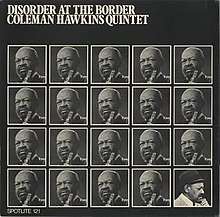Disorder at the Border
Disorder at the Border is a live album by saxophonist Coleman Hawkins compiling tracks which were originally broadcast in 1952 and first released on LP in 1973 on the UK Spotlite label.[1][2][3][4]
| Disorder at the Border | ||||
|---|---|---|---|---|
 | ||||
| Live album by | ||||
| Released | 1973 | |||
| Recorded | September 6 and 13, 1952 | |||
| Venue | Birdland, NYC | |||
| Genre | Jazz | |||
| Length | 43:45 | |||
| Label | Spotlite SPJ 121 | |||
| Coleman Hawkins chronology | ||||
| ||||
Reception
| Review scores | |
|---|---|
| Source | Rating |
| AllMusic | |
On AllMusic, Scott Yanow called it an "erratically recorded but very interesting release" and states, "Although Hawkins's studio recordings from this era were few and generally found him restricted to playing commercial mood music, his concert and club appearances showed him to still be in prime form. This enjoyable LP has the great tenor leading two different quintets at Birdland on broadcasts that were aired just a week apart. The rhythm section features the then-unknown pianist Horace Silver, bassist Curly Russell and either Art Blakey or Connie Kay on drums. More importantly, trumpeters Roy Eldridge and Howard McGhee (heard separately) inspire the competitive Hawkins to play at his best".[5]
Track listing
All compositions by Coleman Hawkins except where noted
- "Disorder at the Border" – 6:55
- "The Blue Room" – 6:55
- "Stuffy" – 7:00
- "Rifftide" – 5:50
- "I Can't Get Started" (Vernon Duke, Ira Gershwin) – 4:10
- "Disorder at the Border" – 5:05
- The Hawk Talks (Interview) – 7:50
- Recorded at Birdland in New York City on September 6, 1952 (tracks 4-6) and September 13, 1952 (tracks 1-3), and in London, England on an unknown date c. 1960 (track 7)
Personnel
- Coleman Hawkins – tenor saxophone
- Roy Eldridge (tracks 1-3), Howard McGhee (tracks 4-6) – trumpet
- Horace Silver – piano
- Curley Russell – bass
- Art Blakey (tracks 1-3), Connie Kay (tracks 4-6) – drums
References
- The Horace Silver Discography: Sideman 1950-1957. Retrieved July 10, 2017
- Chronology of Art Blakey. Retrieved July 10, 2017
- Coleman Hawkins Discography. Retrieved July 10, 2017
- Evensmo, J. The Tenor Sax of Coleman Hawkins Part 3: 1950 – 1959. Retrieved July 10, 2017
- Yanow, Scott. Disorder at the Border – Review at AllMusic. Retrieved July 10, 2017.